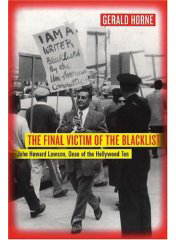
BOOKREVIEW
The Final Victim of the Blacklist: John Howard Lawson, Dean of the Hollywood Ten
By Gerald Horne
University of California Press, 2006
Softcover, 360 pp., $24.95
The Hollywood blacklist of communist and suspected communist writers, actors, directors and others is widely viewed as having been an unconstitutional attack on civil liberties and political rights. Having said that, few people understand the basis on which the blacklist was imposed and the effects it had on the film industry.
“The Final Victim of the Blacklist,” by Gerald Horne, details the life of John Howard Lawson, the “Dean of the Hollywood Ten,” who served as its pre-eminent symbol.
Horne excavates the motives that served to promote the blacklist hysteria: profits for the movie corporations, anti-unionism, anti-Semitism, racism, xenophobia and anti-Sovietism.
Lawson began his career on Broadway and mingled with the great writers of his generation, such as Theodore Dreiser, John Dos Passos, Edna St. Vincent Millay, Mike Gold and many others. His early work places him among the “lost generation” which included renowned writers Ernest Hemingway and F. Scott Fitzgerald. His contribution to early 20th-century playwriting was significant.
Hollywood, along with the challenges of filmmaking, lured Lawson to the West. He soon found himself in the factory-like conditions of early Hollywood. Lawson found that he and his colleagues were the most exploited and least appreciated “talent” on the lot. Writers were sometimes forced to work 70- and 80-hour weeks. Their work was unrewarded by egotistical directors and profit-greedy producers.
Lawson’s budding radicalism impelled him to lead union organizing efforts among screenwriters, and he joined the Communist Party USA. He became a leader for the organized left in Hollywood. Left-wing screenwriters and playwrights brought scripts and story ideas to him. He helped organize several writers’ collectives, including the League of American Writers (LAW) and the Hollywood Writers’ Mobilization.
Writers in the LAW, including Upton Sinclair, Richard Wright, William Faulkner, John Steinbeck, I.F. Stone, Dashiell Hammett, Meridel Le Seuer and Ernest Hemingway, among scores of others, amplified their collective opposition to the fascist Franco regime in Spain.
Lawson became an organizer with the Hollywood Democratic Committee, helping end 44 years of Republican control of California’s governorship and bringing Democrat Cuthbert Olson to office in 1938. Lawson’s role as an activist and leader in Hollywood by the late 1930s became a full-time job in addition to his occupation as a screenwriter.
Lawson produced memorable films of the 1930s and 1940s, such as “Blockade,” “Sahara,” “Action in the North Atlantic” and “Smash Up.” He also wrote several important books on filmmaking and cultural theory.
Several factors gave momentum to the right-wing hysteria that inspired the blacklist. Horne argues that the existence and ideas of the Communist Party, in and of themselves, constituted only a secondary factor.
Communists led in organizing the Hollywood unions, especially the Screenwriters Guild (SWG) with Lawson at its head. Communists made up a large portion of the guild’s membership, numbering in the hundreds. But it was the growing strength of the union the communists helped lead — and the corresponding threat to studio owner profits — that the employers were most alarmed about.
Anti-communism became a means for the employers to weaken the union.
California Republicans launched an attack on Hollywood, specifically targeting communists and sympathizers. State Sen. Jack Tenney and future president Richard M. Nixon led investigations on communist influences. Anti-Semitic and racist FBI reports attacked communists for pro-civil-rights activities, culminating in the right-wing-led HUAC hearings in 1947 and the trial of the Hollywood Ten.
By the late 1940s, the SWG became little more than a small discussion group after leading members like Lawson and others sympathetic to the CPUSA were forced out.
Horne’s special contribution, besides sparkling writing and insightful analysis, is his combination of personal and public elements that will change the image of one of the most maligned figures in American history. Rather than a rigid “commissar” of culture, Lawson is a complex and brilliant figure whose contributions to popular culture and the political landscape deserve renewed consideration.
In an era where red-baiting idiots like David Horowitz have sought to revive McCarthyism, this book serves well to remind us to speak out and make a stand for political freedoms.
jwendland @ politicalaffairs.net









Comments